
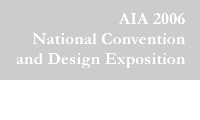
6/2006
LA Matures by Blending Icons with Far-flung Communities

 Turning away from a legacy of car-centric sprawl, Los Angeles is at the cusp of becoming a mature, connected city, agreed theme panelists on day one of the AIA 2006 National Convention in that city.
Turning away from a legacy of car-centric sprawl, Los Angeles is at the cusp of becoming a mature, connected city, agreed theme panelists on day one of the AIA 2006 National Convention in that city.
Keeping with the “Innovation,” as the theme of the first day of the convention, June 8, “We’ve brought together three trend setters who work at the edge, declared AIA President Kate Schwennsen, FAIA. “Their thinking about this city is matched by their extraordinary contributions as catalysts of change.”
The three panelists were:
Craig Webb, AIA, a practicing architect for almost 30 years, the last 17 of which as a principal designer at Gehry Partners. He has worked on the Walt Disney Concert Hall and Grand Avenue housing in Los Angeles; Beekman Street Housing, New York City; King Alfred, a mixed-use project in Brighton, England; the Fisher Performing Arts Center at Bard College, Annandale, N.Y.; and the Jay Pritzker Pavilion, Millennium Park, Chicago.
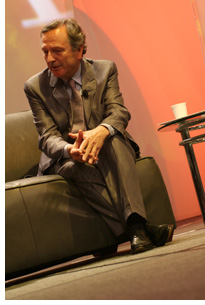 1995 Pritzker Prize Laureate Jose Rafael Moneo, Hon. AIA, one of the leading lights in the current renaissance of Spanish architects and architecture. His projects include: Davis Museum and Cultural Center at Wellesley College, the widely acclaimed addition to Mies van der Rohe’s Fine Arts Museum, Houston; Stockholm’s Museum of Modern Art; and Our Lady of the Angels Cathedral, Los Angeles.
1995 Pritzker Prize Laureate Jose Rafael Moneo, Hon. AIA, one of the leading lights in the current renaissance of Spanish architects and architecture. His projects include: Davis Museum and Cultural Center at Wellesley College, the widely acclaimed addition to Mies van der Rohe’s Fine Arts Museum, Houston; Stockholm’s Museum of Modern Art; and Our Lady of the Angels Cathedral, Los Angeles.
2005 Pritzker Prize Laureate and cofounder of Morphosis, Thom Mayne, FAIA, whose long list of distinguished works includes Los Angeles’ Caltrans District 7 Headquarters and the Science Education Resource Center/Science Center School; Diamond Ranch High School, Pomona, Calif.; Cahill Center for Astrophysics at the California Institute of Technology, Pasadena, Calif.; a GSA federal office building, San Francisco; Wayne L. Morse United States Courthouse, Eugene, Ore.; and the NOAA Satellite Operation Control Facility in Suitland, Md.
Can a nucleus of great architecture transform a city?
Webb began the discussion by explaining that the vitality of Los Angeles is based on the strip. How the iconic buildings reestablish connections will be key to their success in undoing years of sprawl, he said. The Disney Concert Hall, for instance, is on the site of a number of office buildings from the 1980s, which, in turn, had filled in the site of a former Victorian neighborhood that was ripped out in the 1950s. Housing had been missing for a long time. Reestablishing the streetscape and ground plain are the challenge architects face, which goes beyond creation of iconic buildings. But having such buildings creates great opportunities for architects in general, he said.
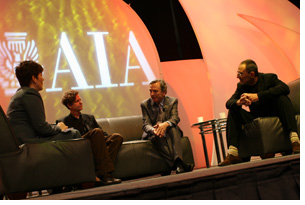 Great buildings create an aura that attracts other buildings and amenities to them, Moneo agreed. “I think this is what happened with Disney. Our Lady of the Angels Cathedral discovers another way of dealing with the scale of LA.” In an effort to establish an entire compound within the fabric of a living pieces of the city, Moneo said, the cathedral acts as a mediator between the scale of huge buildings and the modest scale of housing. The cathedral allows people to own a piece of the city, he said. To think LA can crystallize through iconic buildings is simplistic, though. Strong architectural statement also needs a total building infrastructure of quality and cross-cultural, collective improvement.
Great buildings create an aura that attracts other buildings and amenities to them, Moneo agreed. “I think this is what happened with Disney. Our Lady of the Angels Cathedral discovers another way of dealing with the scale of LA.” In an effort to establish an entire compound within the fabric of a living pieces of the city, Moneo said, the cathedral acts as a mediator between the scale of huge buildings and the modest scale of housing. The cathedral allows people to own a piece of the city, he said. To think LA can crystallize through iconic buildings is simplistic, though. Strong architectural statement also needs a total building infrastructure of quality and cross-cultural, collective improvement.
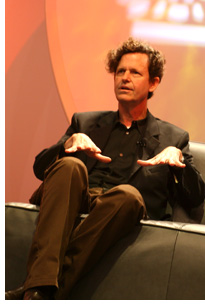 It is a pat answer to say that iconic buildings will solve this city’s problems, Mayne said, but that is wrong. For LA to become a mature city, it will have to contend with all of the complex issues of infrastructure. LA today is not a city; it is a country of 17 million people. With 134 townships, it is a single collection of many centers. The city is typical of those that developed during the second half of the 20th century; a microcosm of the world, Mayne said.
It is a pat answer to say that iconic buildings will solve this city’s problems, Mayne said, but that is wrong. For LA to become a mature city, it will have to contend with all of the complex issues of infrastructure. LA today is not a city; it is a country of 17 million people. With 134 townships, it is a single collection of many centers. The city is typical of those that developed during the second half of the 20th century; a microcosm of the world, Mayne said.
Smaller buildings must hold their own, too
Part of the problem with the iconographic condition of Los Angeles, as well, is the fragility of the elements as they come together, Moneo continued. The humble buildings don’t have the ability to last. Housing has to be able to stand its place against iconic giants needs to be well-built. Some strong problems will come from weak housing, he said.
“I think our work and Moneo’s has sprung from the spontaneity of the smaller buildings,” Webb said. “There is a freedom to explore new ideas here.” He attributed that freedom to a lack of planning, however, which resulted in the strip. “I’m optimistic that this city can solve its transportation problems through planning—incrementally. Overnight mass transit construction won’t work,” he said.
Within the relaxed notion of growth, individual characters have incrementally developed this city in light of no planning, Mayne continued. He added, however, that he would prefer less freedom and more connectivity. An accretion of good work over time is what connects a city within itself, as can be seen in any number of Old World cities, he said.
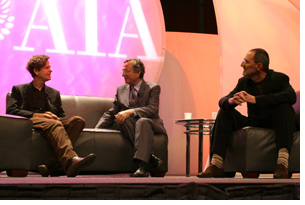 It is easier to work in Europe, Webb agreed, because you’re not struggling to find the connectivity to the urban fabric. It makes U.S. architects work harder to find an area’s roots and fit within that. Nonetheless, cities are built one building at a time, he said. The collective quality of a city is contingent on the quality of individual buildings over time.
It is easier to work in Europe, Webb agreed, because you’re not struggling to find the connectivity to the urban fabric. It makes U.S. architects work harder to find an area’s roots and fit within that. Nonetheless, cities are built one building at a time, he said. The collective quality of a city is contingent on the quality of individual buildings over time.
It’s about time, it’s about space
After WWII, growth was so fast that LA took a turn toward looking like a city, Mayne said. It’s not charming, but it is still actually a harsh and weird village. The city by now may have outlived the iconic phase and maybe it is time to bring the idiosyncratic collection of pieces together into a more mature city.
It is time for all Americans to bring their multi-centric cities together to create lasting consolidations with consistent growth patterns, Moneo added. The time for the highway to be the central infrastructure is over. Americans seem to enjoy their personal amenities more than the more public sense of working together for a common goal, he opined.
And, in a way, LA is the typical American city, Mayne continued. People here are suspicious of the collective actions of city governments. Moreover, what we are talking about in this city is not a cultural enterprise but an economic enterprise. And you don’t have so much a lack of interest in public space. In LA you have a lack of interest in the public. People live within their private spaces, Mayne said. It’s an amazingly opaque city—you have to find a key to get in.
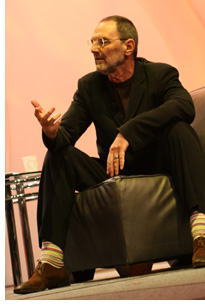 Even in this city there is a longing for iconic buildings to give a sense of place, Webb interjected. People want symbolic architecture that is going to give focus on the city as home. Among those are places for our maturing arts, such as our philharmonic.
Even in this city there is a longing for iconic buildings to give a sense of place, Webb interjected. People want symbolic architecture that is going to give focus on the city as home. Among those are places for our maturing arts, such as our philharmonic.
Plus, there has to be a focus on delivery of amenities to many people, Mayne added. For that to work, there has to be convenient mass conveyance.
Learning from LA for a new urban agenda
To take an active role as part of the solution for a new urban agenda, architects have to become activist, Mayne stressed. Forget political left and right—that’s irrelevant. “Are we going to be where we want to be 20 years from now? It has to start happening now, and it has to start happening with you guys,” he said.
“The public arena is our territory,” said Moneo. He said, for example, that the greatest contribution American architects have brought to housing is to move away from a dependence on manufactured housing and turning instead to existing buildings. Europeans are learning from that, he said.
“I’m optimistic that our new mayor will take on the really difficult issues,” Webb said. In turn, it is architects’ responsibility to contribute ideas to the political realm and make the best buildings to fit the ideal.
LA is and will remain a place of innovation, Mayne concluded. “We understand the poetry and art of our work within the political context. We’ll do the best we can to advance the culture.”
Copyright 2006 The American Institute of Architects.
All rights reserved. Home Page ![]()
![]()
Photos by Aaron Johnson,
Innov8iv Design Incorporated.
![]()